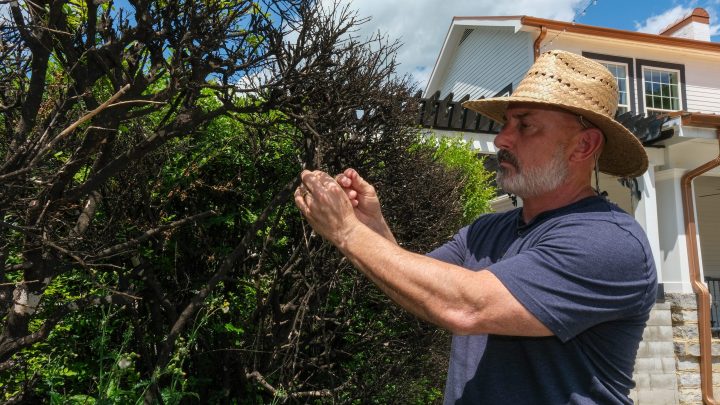
The whiskey drinking boom is causing a “whiskey fungus” boom
The whiskey drinking boom is causing a “whiskey fungus” boom

On a recent humid afternoon, Patrick Long fired up a pressure washer at his family business in Mulberry, Tennessee — a wedding venue with a picturesque white mansion, manicured landscaping and a sprawling green lawn.
The property looked that way from a distance, at least. But up close, a black, crusty fungus was visible that covered pretty much everything — plants, rocks, wood and metal.
“The only way we get it off the house or the structures is with the chemical base,” Long said. “It’s 50% bleach, 50% water.”

The organism is “whiskey fungus,” a mysterious mold named for its preferred diet. It eats ethanol. In Long’s community, the spread of the fungus is linked to the recent boom in whiskey consumption.
Whiskey is now one of the top-selling spirits in the U.S., partially due to the success of Jack Daniel’s. Last year, the company reported a 20% increase in sales of its signature Tennessee liquor.
About an hour and half south of Nashville, Jack Daniel’s has at least 90 warehouses to store aging whiskey. Some are small, but the largest can hold 67,000 wooden barrels. As the whiskey matures inside, ethanol gradually evaporates into the air and escapes the warehouses — and that’s what whiskey fungus eats.
From his property, Long can see one of the newest warehouses built by Jack Daniel’s. The company is planning on building more as part of an expansion that may significantly increase ethanol emissions, according to an application Jack Daniel’s submitted to the Tennessee Department of Environment and Conservation in December.
Whiskey fungus became a problem for Long and some of his neighbors last year. The fungus has coated anything and everything nearby, from street signs and trees to entire homes. Power washing has become a routine activity.

But the abrasive cleanings don’t last. Within a few months, the fungus will be back.
“My business has been destroyed,” Long said. “Now our property is worth considerably less than probably what we paid for it.”
Whiskey fungus looks soft, almost powdery. But it clings to surfaces with a microscopic superglue, part of the fungus’ external digestive system, that makes it hard to remove. It adheres to roofs, windows and even stainless steel.
The fungus has not been documented to harm humans since the spores aren’t airborne like many fungi.
“You don’t see a lot of cells of this thing represented in the air,” said University of Toronto mycologist James Scott, who gave whiskey fungus its scientific name, Baudoinia compniacensis, back in 2007.
Today, there is still very little research on whiskey fungus, according to Scott.
“It’s very understudied, and almost anything that you can learn about it, whether you’re a professional or an amateur, is new information,” he said.
Scientists are unsure how the fungi spreads, but researchers have directly observed tiny trails left by snails in fungus-prone areas. The bottom of a snail is basically a spiky tongue that can grind through the mold.

“Snails seem to really like eating this stuff,” Scott said.
Whiskey fungus is certainly unique, but not unique to Tennessee. Spores are found all over the world, but the black crust seems to sprout up only next to distilleries and bakeries.
To stop the spread, Jack Daniel’s could reduce its ethanol emissions.
“The only way to eliminate the black fungus from the area would be to somehow filter the ethanol,” said Antonis Rokas, a mycologist at Vanderbilt University.
Tennessee does not require distilleries to install air-filtration systems, which are standard fixtures in large brandy distilleries in California.
In an email, Jack Daniel’s said it is not voluntarily planning to install these systems, which can cost several hundred thousand dollars per warehouse.
“There is no reasonably available control technology to prevent ethanol emissions without significantly adversely affecting the taste and quality of Jack Daniel’s or any other aged whiskey,” the company said in a statement.
Jack Daniel’s did not explain how filtration would affect the taste of its products. The company declined to provide an interview.
At the manor, Long passed his hand along a black bush, with branches so brittle they snapped with light contact.
“If you go up there and put your fingers on it, it just cakes off in your hand,” he said.

Landscaping is crucial to his wedding business. Families want photos with lush, green backdrops, Long said, instead of tree stumps and suffocating fungus-encrusted bushes.
And, unlike for his buildings, there are no temporary fixes for the fungus problem.
Long can’t just power wash his plants and trees.
There’s a lot happening in the world. Through it all, Marketplace is here for you.
You rely on Marketplace to break down the world’s events and tell you how it affects you in a fact-based, approachable way. We rely on your financial support to keep making that possible.
Your donation today powers the independent journalism that you rely on. For just $5/month, you can help sustain Marketplace so we can keep reporting on the things that matter to you.

















